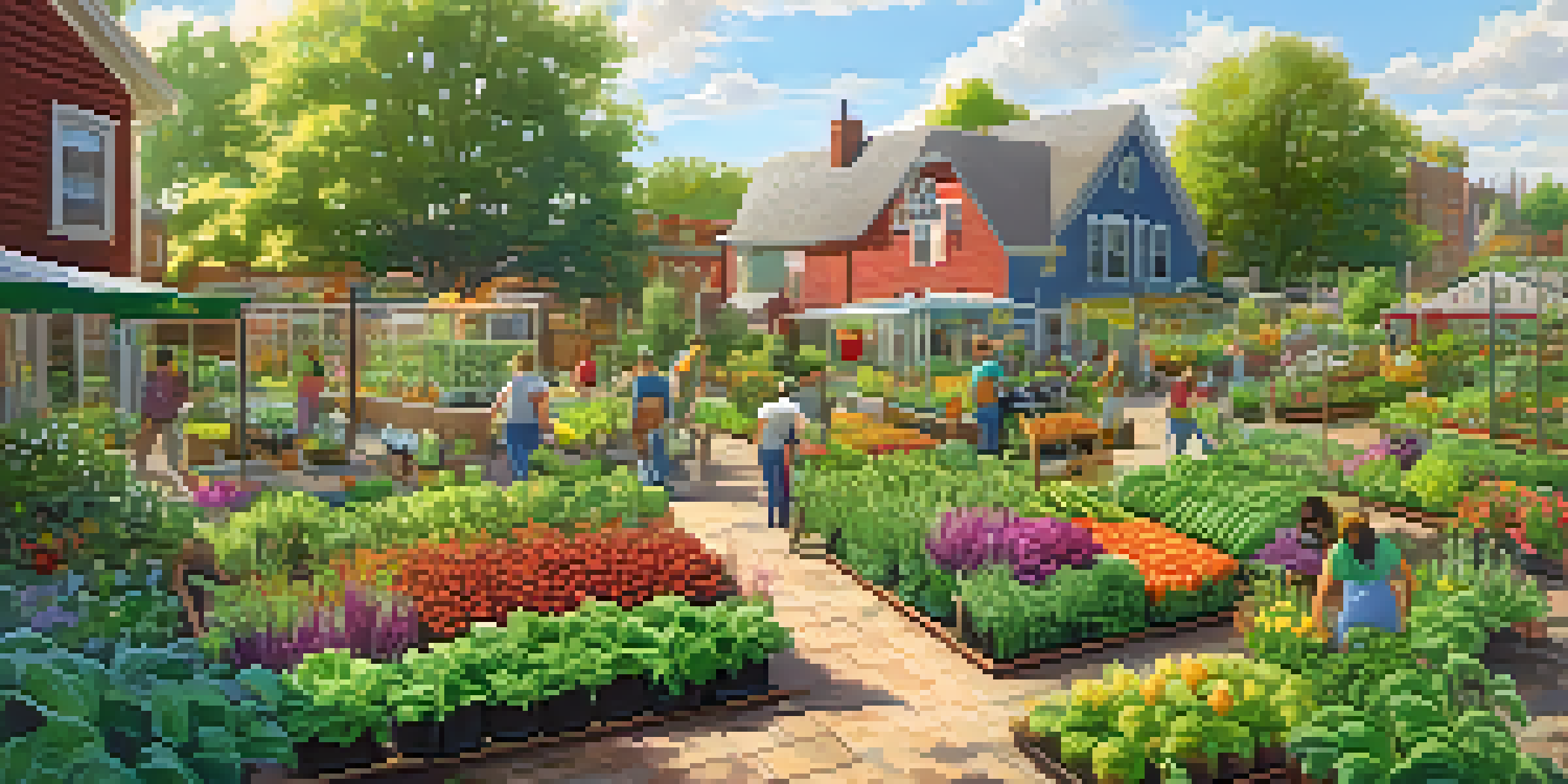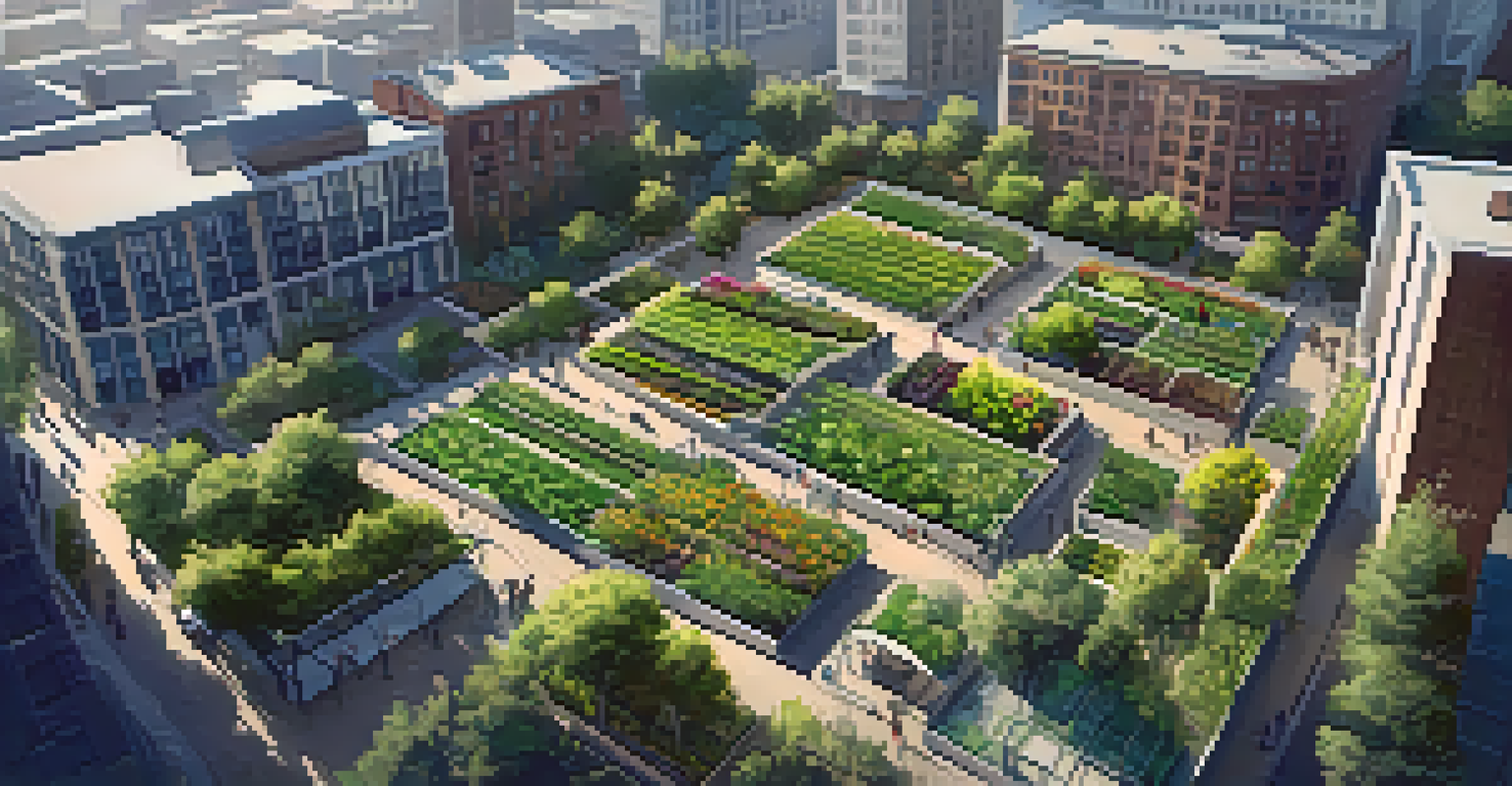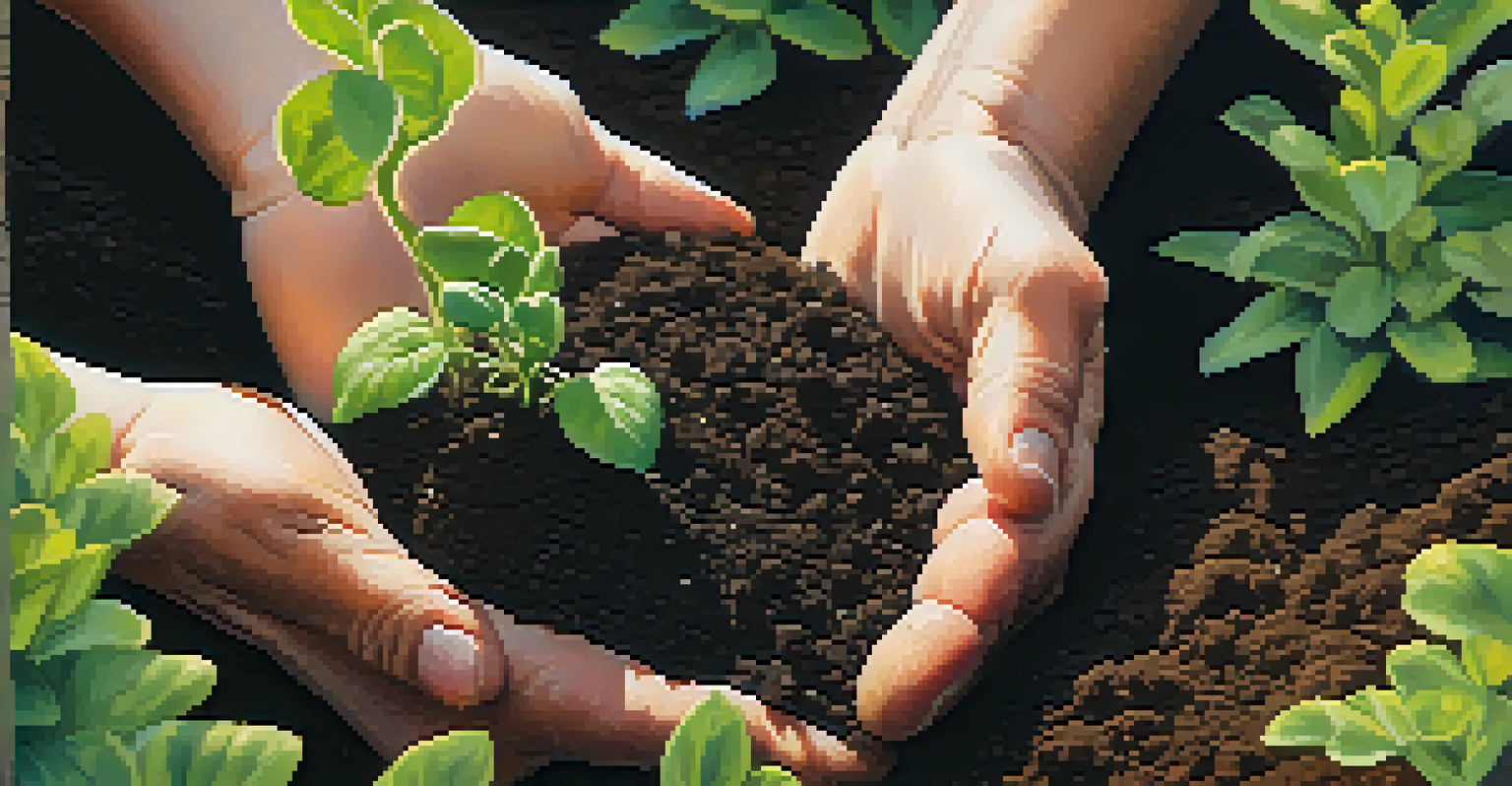How Community Gardening Supports Local Food Production Initiatives

Understanding Community Gardening and Its Purpose
Community gardening is a collaborative effort where individuals come together to cultivate land for food production. These gardens transform underutilized spaces into vibrant areas that not only yield fresh produce but also foster a sense of community. At their core, these initiatives aim to promote sustainable practices while ensuring access to healthy food options for all participants.
Community gardening is a way to bring people together, promote sustainability, and foster a sense of belonging.
Imagine a neighborhood filled with empty lots and concrete; community gardens breathe life into these spaces. They are more than just a place for planting; they serve as hubs for education, sharing knowledge about gardening and nutrition. This collective effort helps neighbors bond over similar goals, creating a shared sense of purpose.
Moreover, community gardens often emphasize organic practices, reducing dependence on chemical fertilizers and pesticides. This commitment to sustainability not only benefits the environment but also contributes to the overall health of the community. As participants learn about eco-friendly gardening, they become advocates for healthier living.
Enhancing Local Food Production Through Collaboration
One of the most significant benefits of community gardening is its ability to boost local food production. By pooling resources and knowledge, community members can grow more food than they might individually. This collaboration creates a diverse array of produce that can meet the needs of the entire community.

For example, a community garden can produce vegetables, fruits, and herbs that are otherwise hard to find in local grocery stores. This enhances food security, providing families with fresh and nutritious options right in their neighborhood. Additionally, the surplus can often be shared or sold at local farmers' markets, further supporting the local economy.
Community Gardens Foster Connection
These gardens unite diverse individuals, creating a sense of belonging and promoting collaborative efforts in local initiatives.
Furthermore, community gardens can help educate participants about seasonal eating and the importance of local food systems. By understanding the growing cycles of different plants, community gardeners can maximize their production and reduce food waste. This knowledge empowers individuals to make informed choices about the food they consume.
Fostering Community Engagement and Inclusivity
Community gardens are unique in their ability to bring together individuals from diverse backgrounds. They create an inclusive environment where everyone, regardless of age or experience, can contribute and learn. This inclusivity fosters a sense of belonging and encourages active participation in local food initiatives.
The future belongs to those who believe in the beauty of their dreams, and community gardens are a testament to that belief.
In many cases, community gardens host workshops, events, and volunteer days that invite everyone to get involved. These gatherings not only make gardening accessible but also allow for the sharing of cultural practices related to food. For instance, traditional cooking methods or unique planting techniques can be showcased, enriching the community's collective knowledge.
As residents work side by side, they build relationships that extend beyond the garden. These connections can lead to collaborative efforts in other community projects, strengthening social ties and enhancing civic engagement. The garden becomes a catalyst for change, promoting a stronger, more connected community.
Promoting Health and Nutrition in the Community
The health benefits of community gardening are profound, as these spaces encourage individuals to consume more fresh produce. By growing their own fruits and vegetables, community members gain access to healthier food options, which can improve overall nutrition. This shift toward fresh, whole foods is essential in combating diet-related health issues.
Moreover, participating in gardening activities provides physical exercise, which is vital for maintaining a healthy lifestyle. Activities like planting, weeding, and harvesting engage various muscle groups and promote cardiovascular health. This dual benefit of gardening—nutrition and exercise—creates a holistic approach to well-being.
Boosting Local Food Production
Community gardening enhances food security by enabling residents to grow fresh produce collectively, thus supporting local economies.
Additionally, community gardens can serve as platforms for nutrition education. Workshops on cooking with fresh ingredients or understanding the benefits of various foods can inspire healthy eating habits. As individuals learn more about nutrition, they become empowered to make healthier choices for themselves and their families.
Environmental Benefits of Community Gardening
Community gardening plays a crucial role in promoting environmental sustainability. By cultivating local food sources, these gardens reduce the carbon footprint associated with transporting food over long distances. This practice not only lowers emissions but also encourages a more resilient local food system.
Moreover, community gardens often prioritize organic growing methods, which help maintain soil health and biodiversity. The use of compost, crop rotation, and companion planting can reduce the need for chemical inputs, leading to healthier ecosystems. As more residents engage with these practices, the community's overall environmental consciousness grows.
Finally, these gardens can enhance urban green spaces, providing habitats for various species and improving air quality. The greenery contributes to a cooler environment, helping combat urban heat islands. In essence, community gardens are a win-win for both people and the planet, fostering a sustainable future.
Economic Impact of Community Gardening Initiatives
Community gardens can be a powerful driver of local economic growth. By producing food locally, they reduce reliance on large commercial farms and grocery chains. This shift not only keeps money circulating within the community but also supports local businesses and farmers.
Additionally, many community gardens operate farmers' markets or farm stands, creating opportunities for local entrepreneurs. These markets showcase not only the produce from the gardens but also handmade goods, crafts, and other local products. This vibrant marketplace fosters a sense of community while providing income for participants.
Health and Sustainability Benefits
Participating in community gardening promotes healthier eating habits and physical activity while encouraging environmentally friendly practices.
Moreover, community gardening initiatives can attract grants and funding, further boosting the local economy. Many organizations recognize the value of sustainable food systems and are willing to invest in these programs. When communities come together to support local food production, they often find ways to secure the resources needed to thrive.
Challenges and Solutions in Community Gardening
While community gardening offers numerous benefits, it also faces its fair share of challenges. Issues such as limited access to land, funding constraints, and varying levels of commitment among participants can hinder progress. However, recognizing these challenges is the first step toward finding effective solutions.
For instance, securing partnerships with local governments or non-profits can provide the necessary support for community gardens. These organizations may offer resources, grants, or even land access, enabling gardens to flourish. Additionally, establishing clear roles and responsibilities can help ensure that all participants remain engaged and invested in the garden's success.

Another solution lies in fostering a culture of inclusivity and education within the garden. By providing training and resources, newcomers can feel more confident in their gardening abilities. This sense of empowerment can lead to increased participation and a more robust community gardening effort, ultimately enhancing local food production initiatives.
The Future of Community Gardening and Local Food Systems
The future of community gardening looks promising, particularly as more people recognize the importance of local food systems. As urbanization continues to grow, these gardens provide a vital connection to nature and sustainable practices. They serve as a model for how communities can adapt to changing environmental and social landscapes.
Moreover, with the rise of food justice movements, community gardening is gaining traction as a means of addressing food inequities. As more individuals advocate for access to fresh produce, community gardens are poised to play a significant role in creating equitable food systems. This shift can empower marginalized communities and enable them to take control of their food sources.
In conclusion, community gardening not only supports local food production initiatives but also fosters community engagement, health, and sustainability. By continuing to nurture these spaces, we can cultivate a brighter, healthier future for all. As we plant the seeds of change today, we pave the way for a more connected and resilient tomorrow.